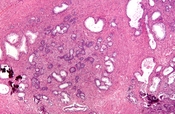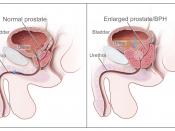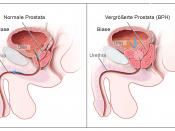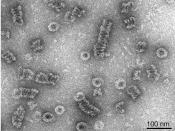A.Benign prostatic hyperplasia (BPH) is characterized as the enlargement of prostate in male in middle and older age. The literature and material related to the BPH was not quite sufficient, which yielded this study. Most of the studies focused on cross-sectional association or studies related to the hospital based case control. Some of the studies were related to risk of incident BPH. The only risk, which was identified earlier, related to BPH was obesity. The need to identify more risk related to the diet and BPH incidence emphasized conducting more studies. The origin and development of BPH is not clearly identified. Some of the factors, which can cause it, can be hormonal alteration and growth regulators. The main purpose of this study was to determine the effects of alcohols, supplements and dietary patterns among 55 years old people (Kristal et. al, 2006).
The data for the study was collected from placebo arm participants in prostate cancer prevention trial (PCPT).
The testes related to the 5 ñ-reductase inhibitor and finasteride were conducted in order to reduce the prostate cancer. The age criterion for the selection of target population was 55 years. The data was collected on the basis of randomized selection among 18,880 males. A self administered questionnaire was used to collect the data related to the age, race, ethnicity, smoking habits, etc. The questionnaire was classified as sedentary, light, moderate and very active. The physical features of the sample were also noted in this process. The data from clinics and hospitals related to cancer, diabetes, BPH and cardiovascular diseases was also collected.
The rate of BPH incidence was calculated as 33.6% per thousand. In 7 years follow-up, 876 cases were identified. The basis of BPH endpoints were medical treatment with 52%, surgery 7% and elevated IPSS 41%. It is clear by the study that there is no BPH risk with energy intake. The results compare different quintiles. In case of total fat by consuming 1 drink/month, the risk was 31% higher. In polyunsaturated fat, it was 27% and in case of protein, it was 15%. In case of 2 drinks/day, the risk was reduced up to 33%. The BPH risk is 32% reduced in the highest quintile by the association of dietary and zinc. Vitamin D is also responsible to reduce BPH risk. BPH risk was increased up to 38% with daily uptake of red meat, whereas 32% risk was reduced with uptake of vegetables.
The discussion part focuses on BPH risk. Some of the points that were included in discussion are given below. Increased BPH risk is directly associated with total fat. Antioxidant nutrients are also associated with the increased risk. The risk of BPH incidence is reduced with the consumption of alcohol. All the studies conducted by the researchers do not support the association of antioxidant nutrients. The energy is controlled with the help of protein and dietary zinc correlation. Sympathetic nervous system and concentration of steroid hormones affected with BPH risk. Obesity is reduced with the consumption of vegetables, alcohols, etc. (Kristal et. al, 2006).
B.
A well systematic treatment is required for BPH. Most of the researchers said that it should be treated in middle enlargement of the gland but the symptoms of the diseases can not be identified at this stage. Some sorts of check ups on regular basis are required for the better treatment and prevention. If a person is infected with the BPH, he or she is treated with antibiotics in order to reduce the infection. In most of the case, the doctors do not allow any kind of treatment until the identification of certain health risk. Some of the treatments of the disease are as follows:Drug treatment: In this treatment, various types of drugs are prescribed by the doctors to control the infection. 6 drugs have been approved by FDA, which are finasteride, dutasteride, terazosin, doxazosin, tamsulosin and alfuzosin. These drugs halt the development of prostate or shrink the enlarged portion.
Minimally invasive therapy: Different types of surgeries are also used for the treatment of the disease. The therapies are as follows:ÃÂTransurethral microwave procedureÃÂTransurethral needle ablationÃÂWater-induced thermotherapyÃÂHigh-intensity focused ultrasound ((National Institute of Diabetes and Digestive and Kidney Diseases, 2006).
Surgical treatment: In this type of treatment, the BPH infected tissues are completely removed by the doctors in order to avoid long term effects of the disease. Various types of surgeries are used to remove BPH and are given below:ÃÂTransurethral surgeryÃÂOpen surgeryÃÂLaser surgeryÃÂPhotoselective vaporization of the prostateÃÂInterstitial laser coagulationRisk and benefit of drug treatment: Drug treatment is one of the best suitable treatments for BPH. The enlarge part of the gland is halted or shrunk by the use of drugs. The drugs used in this treatment are approved by FDA, which shows that they are safe for use. But the access use of these drugs can be harmful for other parts of the body. Finasteride and doxazosin are some of the drugs, which can be most beneficial for the disease if they are, used together (National Institute of Diabetes and Digestive and Kidney Diseases, 2006).
C.
Botanicals are now becoming popular among all types of patients because they are safe to use. Most of the dietary supplements contain vitamins, minerals, medicinal herbs, amino acids, etc. The government of the United States has also passed Dietary Supplements Health and Education Act (DSHEA). This act has also informed the people that the use of botanicals does not cause side effects. Different types of botanicals are now available in the market in the form of tablets, powders, capsules, pills, etc. The people do not get any difficulty to use these items. In case of BPH, the use of botanicals can also be safe for other parts of the body.
Garlic pills, ginkgo biloba, glucosamine are some of the supplements, which contain herbal ingredients and are used by large number of population. The people are becoming more health conscious and are well educated now. They know that what product or material is beneficial for their health. The government health education programs have also enable the people to become aware of all the botanicals, minerals, vitamins, etc. The source of the botanicals is known to the public that it is extracted from herbal plants. Some of the botanicals are specialized to treat a particular disease. These botanicals have proved their effectiveness and become popular among public (Gunther et. al, 2004).
D.
Saw palmetto is one of the widely used botanicals. It is used in the treatment of BPH. It contains saturated and unsaturated fatty acids, oleic acid, palmatic, caprylic, ethyl ester, sterols, etc. The use of this material is safe for human body because they do not cause side effects. It is contained in most of the supplements. A research conducted by Gunther et. al shows that 8 % of 50-79 years aged people use saw palmetto in prostate cancer and 8% use it in enlarged prostate (Gunther et. al, 2004).
The treatment of benign prostate hyperplasia is performed with the use of saw palmetto. Libido and sperm production is increased in male by the use of this botanical. It also acts as urinary antiseptic and prevents other health related damages. Its use in male helps in the prevention of hair loss.
Most of the studies have proven that the use of saw palmetto is safe for human body. If it is used after consulting with the physician, the use of this botanical do not cause any harm. But the use of saw palmetto should be avoided by the patients who are suffering with breast cancer. The medical literature demonstrates that the use of these types of drugs is not harmful because the adverse effects attached with these drugs are low. They can be only some sort of headache, distress, skin reactions, restlessness, etc.
Most of the people utilize saw palmetto on regular basis in the form of dietary supplement. A server conducted by dietary supplement education alliance demonstrates that 12% people from 65 years age use saw palmetto. The people are also supported by the government regularities. American herbal product association has defined some code of ethics for the manufacturers and marketers of these products that the label of these products should show all the ingredients Report to Chairman, Special Committee on Aging, U.S. Senate. (2001).
E.
Saw palmetto is one of the most usable and beneficial botanical drug for various types of human diseases. But the use of this herb should be according to the prescription of the physician. Most of the people whose age is above 50 years use it without consulting with the doctors which can be harmful for their health. The only uptake of saw palmetto can not be beneficial for human beings. The consumption of green vegetables and fruits is also recommended with the use of saw palmetto. Its user should create the habit of regular exercise.
Saw palmetto should not be used by the woman who has breast cancer because the use of his botanical can harm her health. The person who is consuming it should avoid the habit of smoking and alcohol drinking. It is very effective for the treatment of serious diseases, such as prostate cancer and enlarged prostate. The use of saw palmetto is safe. It has been proved by various researches and studies. All the minute adverse effects attached with it can also be removed, if it is used according to the prescription of a medical professional.
ReferencesGunther, S., Patterson, R. T., ?Kristal, A. R., Stratton, K. L. & White, E. (2004). Demographic and Health-Related Correlates ofHerbal and Specialty Supplement Use. American Dietetic Association Vol. 104. P: 27-34.
Kristal, A. R., Arnold, K. B., Schenk, J. M., Neuhouser, M. L., Goodman, P, Penson, D. F. & Thompson, I. M. (2006). Dietary Patterns, Supplement Use, and the Risk of Symptomatic Benign Prostatic Hyperplasia: Results from the Prostate Cancer Prevention Trial. American Journal of Epidemiology Vol. 167(8). P: 925-934.
National Institute of Diabetes and Digestive and Kidney Diseases. (2006). Prostate Enlargement: Benign Prostatic Hyperplasia. U.S. Department of Health and Human Services.
Report to Chairman, Special Committee on Aging, U.S. Senate. (2001). Health Products for Seniors. United States General Accounting Office.




